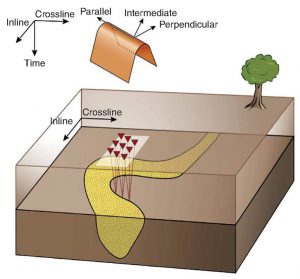
This research aims at predicting the mechanical response based on discrete fracture-fault network models that include intermediate scale (10- 1,000 m) fracture-fault networks. This intermediate scale bridges between the induced small-scale fracturing around boreholes versus the critical loading of faults at the largest length scales for seismic risk. The state of stress down to that of boreholes, results from the interactions of “regional” stress field with the heterogeneities in the relevant sectors of the Dutch ‘shale basins’. Heterogeneities constitute of geological bodies with different mechanical properties and fault and fracture surfaces. As a consequence, the effective stress state between faults can differ significantly from the regional stress field and the degree of loading of faults and failure potential of pre-existing faults can be variable. The effective confining stresses around bore-holes may be reduced by increasing fluid pressures. Influencing the natural in-situ stress conditions that are close to the critical point of failure can result in i) hydraulic fracturing and enhancement of fracture network connectivity and, ii) the reactivation of pre-existing faults. The former can obviously be beneficial to gas extraction, the latter is a potential hazard to be mitigated. The degree by which gas extraction is improved by fluid pressure increase very much depends on the characteristics of the pre-existing fracture network and its response to changes in effective stresses in terms of activation of existing and formation of new fractures.
In this study we perform finite element (FE) geomechanical simulation to quantify mechanical response in terms of loading, failure and growth of complex network of pre-existing fractures-andfaults. This can be done to much greater detail by starting from a pre-existing network than by modelling the incipience of a new network. The characteristics of a pre-existing fracture-fault (F-F) network is best obtained from deterministic reservoir data combined with outcrop analogue studies with. Deterministic F-F network descriptions are used where feasibly, otherwise network characterizations in terms of shape, directions, spacings, heights and lengths are used to describe the discontinuity surfaces.
The TKI Upstream Tough Gas program, initiated in 2013, has initiated a close and strong collaboration on fractures in tough gas reservoirs between the 5 Tough Gas projects of the three universities (UU, TU/e and TU Delft). Together with our industry partners, we have created an overall multi-year strategy named 2F2S that is built around the knowledge that efficient predictions of producibility of tough gas plays, such as gas shales, tight sands or coal seams, can be only achieved a) by adopting a multi-scale approach (cover the mm – km range) to understand the behaviour and transport properties of both natural and man-made fracture systems and intervening rock matrix under in-situ P-T-chemical conditions, and b) by consciously integrating the different disciplines needed to Innovation contract Upstream Gas.
Four overarching challenges have been defined within our 2F2S program with the aim of aligning and integrating the universities’ different expertise and activities covering both the relevant processes (Challenges 1-3) and regional tectonic evolution aspects (Challenge 4). The research proposed here falls at the interface between Challenge 1, 2 and 4 which focusses on the fracture networks developed in natural rocks.
From basin to well
Barnhoorn, A., Verheij, J., Frehner, M., Zhubayev, A., & Houben, M. (2018). Experimental identification of the transition from elasticity to inelasticity from ultrasonic attenuation analyses. Geophysics, 83(4), MR221-MR229. https://doi.org/10.1190/geo2017-0534.1
Boersma, Q., Hardebol, N., Barnhoorn, A., & Bertotti, G. (2018). Mechanical Factors Controlling the Development of Orthogonal and Nested Fracture Network Geometries. Rock Mechanics and Rock Engineering, 1–15. https://doi.org/10.1007/s00603-018-1552-8
Boersma, Q., Hardebol, N., Houben, M., Barnhoorn, A., & Drury, M. (2015). Fracture-fault network characterization of pavement imagery of the Whitby Mudstone, Yorkshire. . EGU General Assembly Conference Abstracts, 17(June), 4–5. https://doi.org/10.3390/ijerph15020236
Hardebol, N. J., Boersma, Q., Barnhoorn, A., Houben, M. E., & Bertotti, G. (2018). Nested fracture network parameterisation from Lower Jurassic shale pavements, Cleveland Basin, United Kingdom. Journal of Structural Geology, [In Prep].
Valliappan, V., Remmers, J. J. C., Barnhoorn, A., & Smeulders, D. M. J. (2017). A Numerical Study on the Effect of Anisotropy on Hydraulic Fractures. Rock Mechanics and Rock Engineering, 1–19. https://doi.org/10.1007/s00603-017-1362-4
Zhubayev, A., Houben, M. E., Smeulders, D. M. J., & Barnhoorn, A. (2016). Ultrasonic velocity and attenuation anisotropy of shales, Whitby, United Kingdom. Geophysics, 81(1), D45–D56. https://doi.org/10.1190/geo2015-0211.1